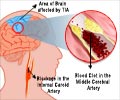Countries with low national income have higher rates of death and disability associated with stroke than from heart disease.

But the relative rates of death and disability from heart disease and stroke vary considerably from country to country.
For example, "in the United States, heart disease is still the No. 1 cause of death, but stroke recently went from No. 3 to No. 4 (according to CDC data)," said Anthony S. Kim, M.D., co-author of the study and assistant professor of neurology at the University of California, San Francisco. "Whereas, in China, WHO data shows the situation is nearly reversed � they are facing an epidemic of cerebrovascular disease, and stroke is the leading cause of death."
From WHO data on death rates and disease burden, Kim and co-author S. Claiborne Johnston, M.D., Ph.D., found that stroke death rates exceeded heart disease death rates in 74 of 192 countries (nearly 40 percent). In 62 countries (nearly one-third), the burden of disease from stroke � measured in disability adjusted life year (DALY) loss rates � also surpassed that of heart disease.
The Pacific island republic of Kiribati topped both lists with a death rate and a disease burden from stroke about 11 times higher than mortality and disease burden from ischemic heart disease.
At the other end of the scale, Azerbaijan had a mortality rate from ischemic heart disease three times that from stroke, and Turkmenistan had a disease burden from ischemic heart disease more than five times that from stroke.
Advertisement
"At first, one might think that this is simply a reflection of the different patterns of risk factors operating in different countries, but it is actually much more complicated than that," Kim said.
Advertisement
"Researchers and policy makers often think of stroke and heart disease together when designing cardiovascular disease prevention programs. But there may be important reasons to consider the two separately as well," Kim said.
For example, if a country has three times the disease burden from stroke than it does from heart disease, one could imagine a situation where a broad-based intervention to tackle cardiovascular disease more generally might not have as much impact as a program specifically targeting extremely high blood pressure, since this is a much more potent risk factor for stroke than for heart disease.
"Ultimately, the goal is to better understand the reasons behind these differences in order to develop interventions to address the specific issues in a particular country," Kim said.
Source-Eurekalert














